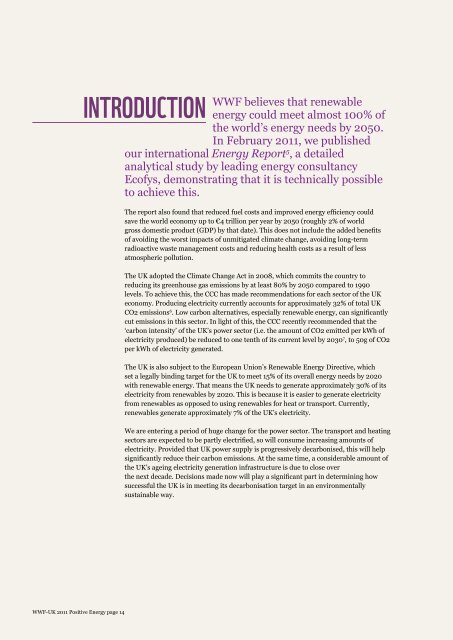Positive Energy: how renewable electricity can transform ... - WWF UK
Positive Energy: how renewable electricity can transform ... - WWF UK
Positive Energy: how renewable electricity can transform ... - WWF UK
You also want an ePaper? Increase the reach of your titles
YUMPU automatically turns print PDFs into web optimized ePapers that Google loves.
introduction<br />
<strong>WWF</strong> believes that <strong>renewable</strong><br />
energy could meet almost 100% of<br />
the world’s energy needs by 2050.<br />
In February 2011, we published<br />
our international <strong>Energy</strong> Report 5 , a detailed<br />
analytical study by leading energy consultancy<br />
Ecofys, demonstrating that it is technically possible<br />
to achieve this.<br />
The report also found that reduced fuel costs and improved energy efficiency could<br />
save the world economy up to €4 trillion per year by 2050 (roughly 2% of world<br />
gross domestic product (GDP) by that date). This does not include the added benefits<br />
of avoiding the worst impacts of unmitigated climate change, avoiding long-term<br />
radioactive waste management costs and reducing health costs as a result of less<br />
atmospheric pollution.<br />
The <strong>UK</strong> adopted the Climate Change Act in 2008, which commits the country to<br />
reducing its greenhouse gas emissions by at least 80% by 2050 compared to 1990<br />
levels. To achieve this, the CCC has made recommendations for each sector of the <strong>UK</strong><br />
economy. Producing <strong>electricity</strong> currently accounts for approximately 32% of total <strong>UK</strong><br />
CO2 emissions 6 . Low carbon alternatives, especially <strong>renewable</strong> energy, <strong>can</strong> signifi<strong>can</strong>tly<br />
cut emissions in this sector. In light of this, the CCC recently recommended that the<br />
‘carbon intensity’ of the <strong>UK</strong>’s power sector (i.e. the amount of CO2 emitted per kWh of<br />
<strong>electricity</strong> produced) be reduced to one tenth of its current level by 2030 7 , to 50g of CO2<br />
per kWh of <strong>electricity</strong> generated.<br />
The <strong>UK</strong> is also subject to the European Union’s Renewable <strong>Energy</strong> Directive, which<br />
set a legally binding target for the <strong>UK</strong> to meet 15% of its overall energy needs by 2020<br />
with <strong>renewable</strong> energy. That means the <strong>UK</strong> needs to generate approximately 30% of its<br />
<strong>electricity</strong> from <strong>renewable</strong>s by 2020. This is because it is easier to generate <strong>electricity</strong><br />
from <strong>renewable</strong>s as opposed to using <strong>renewable</strong>s for heat or transport. Currently,<br />
<strong>renewable</strong>s generate approximately 7% of the <strong>UK</strong>’s <strong>electricity</strong>.<br />
We are entering a period of huge change for the power sector. The transport and heating<br />
sectors are expected to be partly electrified, so will consume increasing amounts of<br />
<strong>electricity</strong>. Provided that <strong>UK</strong> power supply is progressively decarbonised, this will help<br />
signifi<strong>can</strong>tly reduce their carbon emissions. At the same time, a considerable amount of<br />
the <strong>UK</strong>’s ageing <strong>electricity</strong> generation infrastructure is due to close over<br />
the next decade. Decisions made now will play a signifi<strong>can</strong>t part in determining <strong>how</strong><br />
successful the <strong>UK</strong> is in meeting its decarbonisation target in an environmentally<br />
sustainable way.<br />
<strong>WWF</strong>-<strong>UK</strong> 2011 <strong>Positive</strong> <strong>Energy</strong> page 14

















